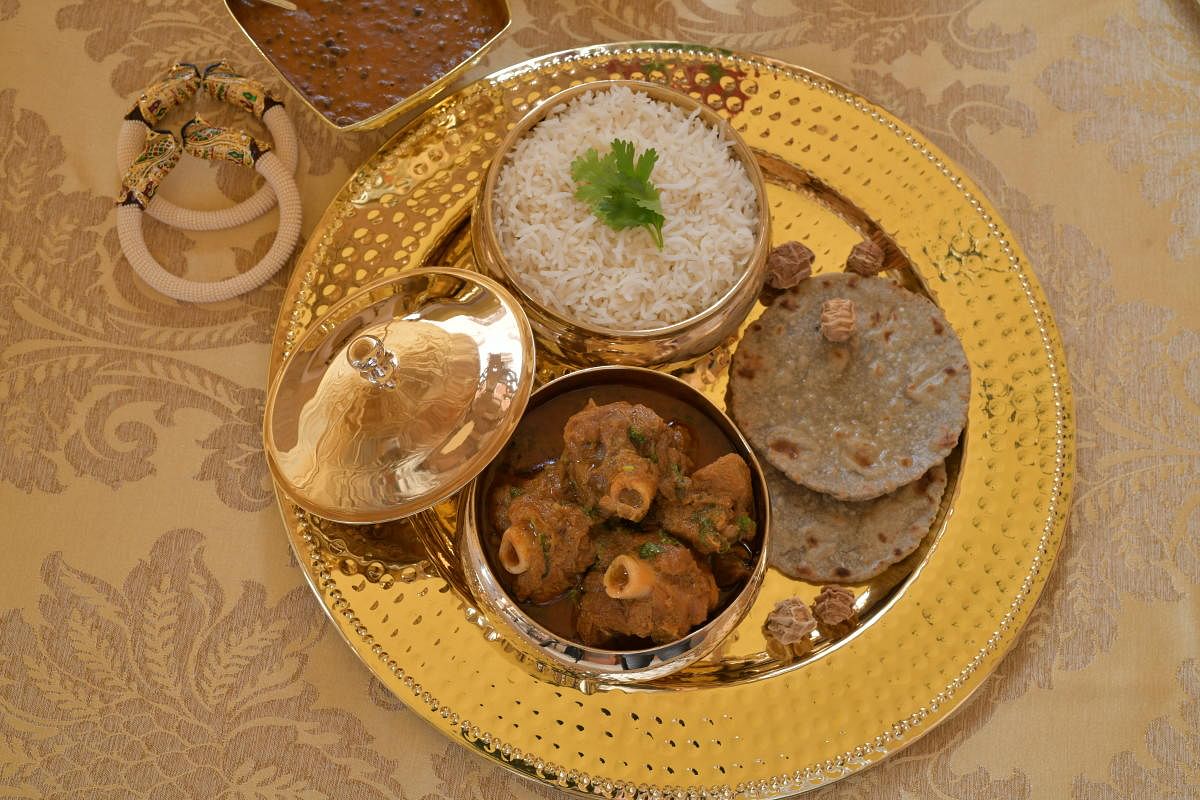
Think Rajasthan and meat, and chances are that the mind deviates towards the fiery red laal maas. After all, it is not only a well-loved meat curry in the erstwhile warrior state, but also the poster boy of their vibrant cuisine. In fact, it remains one of the most innovative dishes with versions perfected by both families and chefs — and one is likely to come across plenty of them while traversing Rajasthan.
It’s royalty’s favourite
But for most denizens, laal maas marks the delicious start to a long array of mutton dishes that are served as part of a celebratory meal — even in the house of royals. “Mutton,” says Akshraj Jodha, executive chef, ITC Windsor, “is an integral part of Rajasthani food culture. It is seen both as a survival food as well as a celebratory dish that can bring people together. And that is the reason that one would find a lot of mutton dishes both in Mewari as well as Marwari cuisine — the two foundation pillars of our cuisine.”
“What is fascinating about these mutton dishes,” adds the scion of the Deolia Kalan (Rathore lineage), “is not only the similar style of cooking these dishes, but the fact that most of them have been influenced by each other and are the perfect example of sustainable cooking.”
Take the case of the laal maas itself. This recipe that developed roughly about 800 years ago as part of a travellers’ substantial meal uses almost every meat cut possible from a wild boar, deer or now common lamb. “In fact,” says Sujoy Gupta, executive chef, Taj Bengal, “it draws its unique flavour from two ingredients: the base flavouring is from the bone and fat, while the finishing flavours come from the Mathania mirch, which also gives its red colour and that spicy-sweet introductory mouth feel.”
Chef Jodha says, “Fascinatingly, for many dishes, it is the same combination at work. Whether it is the rustic junglee maas that is the perfect example of rendering the fat and juices of meat to get that nice, gelatinous mouthfeel of a meaty-curry; which is a trademark of the best junglee maas, which many believe is the dish that inspired laal maas.”
But in all honesty, junglee maas, much like its famous cousin, was developed by the royal cooks as part of the first meal that the royal hunting party would have. Chef Jodha says, “It was mandatory that the post-hunt meal was lavish with at least one of two dishes made of the kill. Enter junglee maas and kachar maas.”
Comforting stews
Made with no more ingredients than oil — ghee or mustard oil — salt, turmeric and chilli, the main difference between the two was the use of kachar, a fresh sour berry that grew in abundance in the hunting area. “In fact,” says Chef Gupta, “Kachar was discovered by one of the Marwari cook, who found it an excellent tenderiser and souring agent.”
Back then, this was akin to striking gold as preserving meat was one of the big challenges of the kitchen. What also helped was the fact that kachar-like aamchur could be dried and carried along.
This is how a stew that debuted as one of the clever dishes at a hunting party soon became a part of the regular fare, the slightly tangy taste giving it its own identity. Chef Gupta, who has spent years with Maharaja Gaj Singh’s family, says, “It soon emerged to be a special treat in the small get-togethers that the Maharaja had in the palace. The family has its own heirloom recipe of kachar maas.”
The zero-waste principle followed by the cooks then also led to another stunning meat preparation called maans ki mokal. This travellers’ dish is a rare find today, but back then was valued as much as water. Made with clarified butter (ghee), amchur, red chili powder and rock salt, it was slow-cooked till the meat lost its moisture and became dry. It could last for a week and was part of any traveller’s kit. “The only caution was to ensure no moisture seeped in,” says Chef Jodha.
So strong were the culinary makes of junglee maas, laal maas and kachar maas that they soon became the core of many more mutton dishes that came into existence in the past 200 years, like the safed maas. Although folklore often calls it the zanana version of the laal maas, which was mostly made by male (cooks), the dish came into existence to pander to the subtle palates that found laal maas a wee bit on the high side of spice.
Chef Jodha says, “Preparing it followed the same process of rendering the meat first and then adding more flavours.” In this case, it was a blend of onion paste, white pepper powder and cashew paste. Many believe that safed maas was a dish that portrayed the century-old friendship between the Rajputs and the Mughals — and how each influenced the other in food.
Another dish that became the beacon of the new culinary chapter of Rajasthan was the maans ki kadhi, which is essentially meat in the popular kadhi gravy. Unlike the rustic, four-ingredient ancestors, maans ki kadhi, which came in the last 300 years, had more nuances to it and includes browned garlic, cumin and hing along with onions and green chillies. Slow-cooked, it has browned garlic and onions along with green chillies.